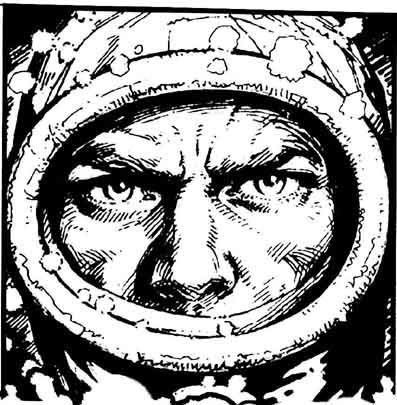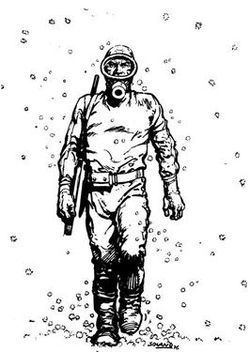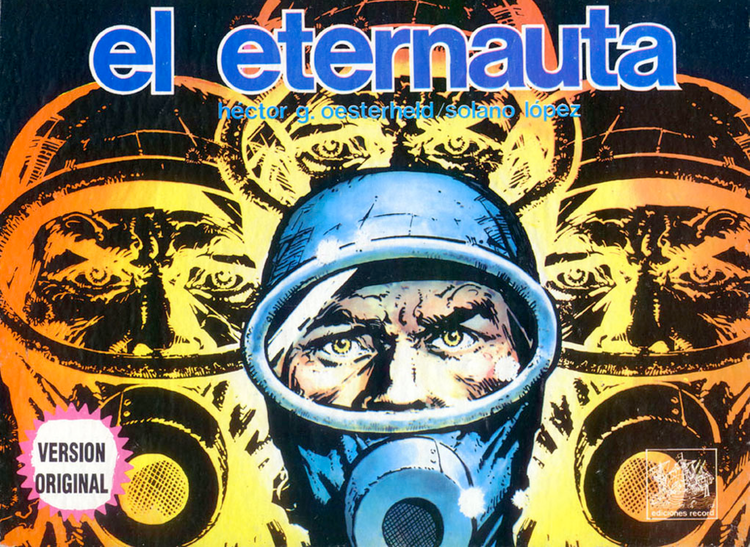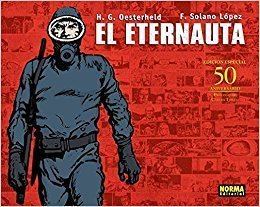Format Limited series Writer Héctor Germán Oesterheld Penciller Francisco Solano López | Publication date 1957-1959 Genre Post-Apocalyptic fiction Publisher Editorial Frontera | |
 | ||
Similar Mort Cinder, Ernie Pike, Sergeant Kirk, Nippur de Lagash, Patoruzú | ||
El Eternauta is a science fiction comic created by Argentine comic strip writer Héctor Germán Oesterheld with artwork by Francisco Solano López. It was first published in Hora Cero Semanal from 1957 to 1959.
Contents

Oesterheld returned to El Eternauta with a remake and a sequel, published in 1969 and 1975, respectively. Both featured a more political script, as Oesterheld was disturbed by political conditions in the nation after military juntas had overthrown elected governments. By the time he published the sequel, he and his daughters had joined the Montoneros leftist guerrilla group. Oesterheld disappeared in 1977, was seen in prisons, and is believed to have died about 1979 at the hands of government forces.

After a change in government and restoration of democracy, since 1983 El Eternauta has been continued in different versions by a variety of writers and artists.

Publication history

The Eternauta was first published in Hora Cero Suplemento Semanal on September 4, 1957. Quickly becoming a success, the serial publication ran until 1959. It was reissued in 1961 in a dedicated magazine, Eternauta, published by Editorial Emilio Ramírez.

In 1969, Oesterheld rewrote El Eternauta, with changes to the story, more political references and more violence. It became an open critique of dictatorial regimes and United States' imperialism. This version featured artwork by Alberto Breccia, who drew the story in an experimental and unique style diverging from the original expression. It was first published on May 29, 1969 in the weekly Gente. The following years the series was also published in several European magazines, such as Linus, El Globo, Alter Alter, Il Mago, Charlie Mensuel and Metal Hurlant.
In December 1975, Ediciones Record, the publishing company which Oesterheld had founded with his brother, began publishing new episodes of Eternauta II in Skorpio. Oesterheld resumed the story, with artwork by Solano López. Disturbed by the Dirty War and political repression of the period, Oesterheld criticized the dictatorship. He placed himself as a narrating character within the story. Having joined the banned leftist organization Montoneros with his daughters, Oesterheld wrote the chapters from hidden locations. He disappeared in 1977, believed abducted by government forces. Oesterheld is believed to have died after 1979, when he was last reported alive. His daughters also disappeared, as were their husbands. Only his widow and two grandsons survived, the youngest boy recovered from government custody after being born while his mother was in prison.
Other authors have continued the saga. A third part, El Eternauta, Tercera Parte (1983), published after the restoration of democracy, met with moderate success. It was criticized for being just another sci-fi comic instead of a continuation of the series' political content. Later chapters, El mundo arrepentido and El Eternauta, El regreso, feature artwork by Solano López.
Fantagraphics Books published the first translation into English, under the name "The Eternaut". It was translated by Erica Mena. It is the first time that the book was published in the English language.
Works by Oesterheld
By others
Plot
The story begins as a deadly snowfall covers Buenos Aires and the surrounding metropolitan area, wiping out most life in a few hours. Juan Salvo, along with a couple of friends (Favalli, Lucas and Polski who were playing truco at his house), his wife and daughter remain safe from the lethal snowflakes thanks to the protection of Juan Salvo's home and the cleverness of Favalli. They organize to survive the ordeal, making special suits to be able to leave the house to gather supplies. During these trips they find Pablo, a twelve-year-old boy, and realize that crazed or needy survivors may be as much of a threat as the deadly snow.
A few days into the snowfall, they learn that the phenomenon was caused by an extraterrestrial invasion to Earth. They are recruited into an improvised resistance army to fight the invaders. During this time, Salvo meets and befriends a few of his fellow soldiers, namely Franco, a lathe operator, and Mosca, a journalist. As the insurgents march towards the country's capital city, they fight on different occasions against giant insects (cascarudos, "beetles"); a humanoid species with many more fingers than humans, especially on their right hands (Manos, "Hands"); giant elephantine beasts capable of knocking buildings down ("Gurbos"); and fellow men who were captured and altered (hombres-robot, "robot-men"). All of these beings are pawns, remotely controlled through implants or fear devices by the real invaders, los Ellos ("Them"), unseen creatures who remain hidden, controlling everything from the distance.
After managing a few victories, the resistance forces are ambushed and reduced to a few men. Juan Salvo decides to return to his wife and daughter to go into hiding with them. A passing ICBM convinces Favalli and Franco that a larger global war is starting, and that they can't return empty-handed. Salvo reluctantly agrees to join them. After the trio attacks the aliens' HQ in Buenos Aires, taking down the "anti-nukes field", they flee. Buenos Aires is leveled by a nuclear warhead.
Gradually the aliens lure the pockets of survivors throughout the country to "snow-free zones" as part of an elaborate ruse. Salvo's group splits, and he tries to escape with his wife and daughter using one of the alien spaceships. He accidentally triggers a time traveling apparatus in the craft. As a result, the three are lost in separate time dimensions known as "continuums". Juan Salvo begins to travel through time seeking them, eventually being named Eternauta, a voyager of eternity.
Trivia
Analysis
Numerous comic book artists and members of the specialized press have remarked on Oesterheld's amplitude of subtle interpretations, veiled references and double readings. Oesterheld indicated that the protagonists were always a group of people - sometimes bigger, sometimes smaller - something he terms a "group hero" or "hero-in-group." He believed this was a more valuable concept than the traditional individual hero who appears to triumph without help from others.
Critics have frequently likened the invaders and their methods as veiled references to the various military-led coup d'états which occurred at the time in the country. The three versions written by Oesterheld (the first part, its remake and the second part) were contemporaneous with the de facto governments of Pedro Eugenio Aramburu, Juan Carlos Onganía and the Proceso de Reorganización Nacional, respectively.
It has also been noted that, except for the "Ellos", none of the invaders is truly evil; they are noble beings forced to carry out the orders of others. Critics believe Oesterheld was conceptually attacking the Dirty War or writing an allegory of class struggle.
Film adaptation
Directors such as Adolfo Aristarain, Fernando Solanas or Gustavo Mosquera expressed interest in a film adaptation, but could not manage reasonable production costs.
In 2008, under supervision by Elsa Oesterheld, the writer's widow, an Italian production company worked on a film adaptation of the original comic. The story would be set in Buenos Aires and the possibility of co-producing the film with INCAA was discussed. Lucrecia Martel was reported as slated to direct the film and said that production was already past the "embryonic stages." In 2009, however, Martel was dropped due to conceptual differences with the producers.
